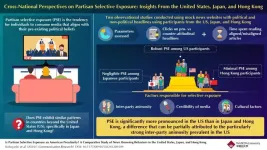(Press-News.org) Waltham — November 11, 2024 — Two measures of patient well-being, designed for use in busy clinical settings, are described in a Perspective piece in a supplement to Medical Care, the official journal of the Medical Care Section of the American Public Health Association. The journal is published in the Lippincott portfolio by Wolters Kluwer. The journal is published in the Lippincott portfolio by Wolters Kluwer.
The Medical Care piece describes perspectives and research surrounding well-being and whole person outcomes and measurement, which was the focus of a recent VA State of the Art (SOTA) conference on this topic. The conference was part of the ongoing effort in VA to move towards a “Whole Health” approach which focuses on what matters most to the veteran.
"In recent years there has been a growing call for healthcare providers to expand their primary focus beyond treating disease to addressing the needs of the 'whole person'," the developers of the tools note. "Yet healthcare providers have received little guidance regarding which well-being measures are best suited to the clinical context or how these measures may be best applied to enhance clinical practice."
In response to this problem, Dawne S. Vogt, PhD, a research scientist at the National Center for PTSD within the VA Boston Healthcare System and a professor of psychiatry at Boston University Chobanian & Avedisian School of Medicine, and colleagues in the Veterans Health Administration created two assessment tools: Well-Being Signs (WBS) and Well-Being Brief (WBB).
Well-Being Signs can guide treatment planning
The WBS can be self-administered or administered by a clinician in less than one minute. On scales of 0 to 10, the patient indicates how often they have participated in the roles and activities that are most important to them, functioned their best in those endeavors, and were fully satisfied with how things are going in those aspects of their lives.
Information from the WBS can prompt discussion between a patient and a healthcare professional about how treatment plans may be designed and/or modified to best optimize the patient’s well-being and whether additional support may be needed to address areas of lower well-being. Psychometric testing is complete and the WBS is now available to the field.
The Well-Being Brief is more in-depth but still efficient
The WBB is a self-administered measure that can be completed in about six minutes and is used to evaluate four areas in which the patient may benefit from support that extends beyond medical care:
Vocation—How well an individual is doing in their vocational pursuits, including their involvement, functioning, and satisfaction with regard to paid work, education and training experiences, and caregiving activities.
Financial—How well an individual is doing with regard to their financial circumstances, including their ability to meet basic needs for food and shelter, transportation, and legal needs and their ability to prepare for their financial future.
Health—The extent to which individuals are experiencing good health states, are engaging in health-promoting behaviors, and perceive that their health and health care access allows them to live their lives as they wish.
Social—The extent to which individuals have social ties, function well in their social interactions, and are satisfied with their relationships with intimate partners, friends, and family and their broader community.
The WBB was designed to inform referrals to professionals and programs that support well-being. For example, it can identify patients who would benefit from career counseling, financial-management support, or counseling to improve their social relationships.
Dr. Vogt and her colleagues say that although they have only just begun to explore how well-being measurements can be used in clinical care, "we are optimistic that attending to the well-being of the 'whole person' can better meet patients’ needs and improve healthcare outcomes."
Wolters Kluwer provides trusted clinical technology and evidence-based solutions that engage clinicians, patients, researchers and students in effective decision-making and outcomes across health care. We support clinical effectiveness, learning and research, and clinical surveillance and compliance, as well as data solutions. For more information about our solutions, visit https://www.wolterskluwer.com/en/health.
###
About Wolters Kluwer
Wolters Kluwer (EURONEXT: WKL) is a global leader in information, software, and services for professionals in health care, tax and accounting, financial and corporate compliance, legal and regulatory, and corporate performance and ESG. We help our customers make critical decisions every day by providing expert solutions that combine deep domain knowledge with specialized technology and services.
Wolters Kluwer reported 2023 annual revenues of €5.6 billion. The group serves customers in over 180 countries, maintains operations in over 40 countries, and employs approximately 21,400 people worldwide. The company is headquartered in Alphen aan den Rijn, the Netherlands.
For more information, visit www.wolterskluwer.com and follow us on LinkedIn, Facebook, and YouTube.
END
New measures of patient well-being can be applied readily in clinical care
A three-item measure can be used to optimize treatment planning; another measure identifies needs for support beyond healthcare and can inform referrals
2024-11-11
ELSE PRESS RELEASES FROM THIS DATE:
New study links historical redlining to delays in HIV treatment
2024-11-11
A new study from Tulane University finds that historical race-based lending practices are still impacting health today, linking these discriminatory policies to delays in effective HIV treatment within affected neighborhoods.
The lending practice, called redlining, was abolished in 1968. Yet, those living in once historically redlined neighborhoods experience 15% longer delays in achieving viral suppression of HIV compared to those in non-redlined areas, according to the study published in JAMA Internal Medicine.
The disparity can impact both individual ...
Understanding causes of echo chambers: Political news selective exposure across countries
2024-11-11
In our digital age, with easy access to a vast array of information, one would think that readers would naturally be exposed to a wide range of perspectives. However, the opposite seems to be happening, especially in countries like the United States (US), where people often seek out news that reinforces their existing beliefs and avoid content that challenges them. This tendency, known as partisan selective exposure, has been linked to increasing divides and tensions between different ideological groups. But is ...
New study reveals unique adaptations of jaw function and tooth wear in hypercarnivores
2024-11-11
A new study led by Dr. Jack Tseng and published in PeerJ Life & Environment has shed light on the intricate relationship between tooth wear and jaw mechanics in highly carnivorous mammals, known as hypercarnivores. As mammalian teeth do not regenerate, these animals often face declining bite efficiency as their teeth wear down over time. This research explores how different hypercarnivorous species, including scavengers, meat specialists, and bone-cracking predators, adapt biomechanically and possibly behaviorally to manage the challenges posed by tooth wear.
The ...
Robot that watched surgery videos performs with skill of human doctor
2024-11-11
A robot, trained for the first time by watching videos of seasoned surgeons, executed the same surgical procedures as skillfully as the human doctors.
The successful use of imitation learning to train surgical robots eliminates the need to program robots with each individual move required during a medical procedure and brings the field of robotic surgery closer to true autonomy, where robots could perform complex surgeries without human help.
“It’s really magical to have this model and all we do is feed it camera input and it can predict the robotic ...
“Emotional contagion” a factor in senior’s mental health
2024-11-11
Madeleine and Paul are sitting on a park bench. As she tells Paul about her financial worries and how she’s been struggling for months to make ends meet, Madeleine’s eyes well with tears. Paul is moved by her distress; her woes resonate with him and heighten his own fears. His heart grows heavy and his own eyes become moist, too.
What’s going on? A kind of behavioural mirroring, what psychologists call “emotional contagion.”
“Just as some people are more likely to catch a respiratory virus through close contact, others are more susceptible to ‘catching’ the emotions of the people around them,” explained Marie-Josée ...
Fear of another heart attack may be a major source of ongoing stress for survivors
2024-11-11
Research Highlights:
Fear of another heart attack was a significant ongoing contributor to how heart attack survivors perceive their health, according to a new study.
While anxiety and depression are recognized as common conditions after a heart attack, they did not explain the impact of fear of recurrence in this study.
The researchers suggest that fear of another heart attack should be evaluated and addressed separately from depression and anxiety.
Note: The study featured in this news release is a research abstract. Abstracts presented at the American ...
Let’s talk about sex: Heart patients want guidance from health care professionals
2024-11-11
Research Highlights:
A small survey of adults aged 30 to 89 (average age of 65) in Sweden who have heart conditions found that there is a significant difference between the sexual health information they seek and what is provided to them by their health care professionals and the health care system.
Despite 76% of patients with heart conditions reporting that sexual health affects their mood and well-being, only 5% received information or counseling about sexual health.
Researchers suggest health care professionals adjust their patient care practices to ensure that discussing sexual health becomes a standard and respected topic in health ...
Heart disease more common in past redlined areas linked to limited access to healthy foods
2024-11-11
Research Highlights:
Heart disease, Type 2 diabetes, high blood pressure and obesity were more common and linked to reduced access to healthy food among people who lived in neighborhoods previously subjected to structural racism-based policies that limited home ownership — an outlawed practice known as redlining.
Researchers say testing interventions to help improve access to healthy food or boost social and economic resources could mitigate the still-present impact of outdated policies like redlining.
Note: The study featured in this news release is a research abstract. Abstracts presented at American Heart Association’s scientific meetings are not peer-reviewed, and the ...
Heart disease could hit up to 28 years sooner for people with CKM syndrome
2024-11-11
Research Highlights:
Scientists conducted a simulation study to estimate the impact of cardiovascular-kidney-metabolic (CKM) syndrome on cardiovascular disease (CVD) risk prediction.
The study found that adults with chronic kidney disease would have elevated CVD risk eight years earlier than those without the disease. In addition, people with Type 2 diabetes would have an elevated CVD risk about a decade sooner than those without it.
Among adults with both Type 2 diabetes and chronic kidney disease, women ...
MESA heart disease risk score worked well with or without race included
2024-11-11
Research Highlights:
A version of the Multi-Ethnic Study of Atherosclerosis (MESA) heart disease risk score that did not include race predicted heart disease risk just as well as the original version that includes race.
The original MESA risk score, developed in 2015[1], combines traditional risk factors, sex and race with a coronary artery calcium score.
The MESA formula without race may be used for people who identify with more than one racial or ethnic group or those who prefer not to disclose their race or ethnicity.
Note: The study featured in this ...
LAST 30 PRESS RELEASES:
University of Oklahoma researcher awarded funding to pursue AI-powered material design
Exploring how the visual system recovers following injury
Support for parents with infants at pediatric check-ups leads to better reading and math skills in elementary school
Kids’ behavioral health is a growing share of family health costs
Day & night: Cancer disrupts the brain’s natural rhythm
COVID-19 vaccination significantly reduces risk to pregnant women and baby
The role of vaccination in maternal and perinatal outcomes associated with COVID-19 in pregnancy
Mayo Clinic smartwatch system helps parents shorten and defuse children's severe tantrums early
Behavioral health spending spikes to 40% of all children’s health expenditures, nearly doubling in a decade
Digital cognitive behavioral treatment for generalized anxiety disorder
Expenditures for pediatric behavioral health care over time and estimated family financial burden
Air conditioning in nursing homes and mortality during extreme heat
The Alps to lose a record number of glaciers in the next decade
What makes a good proton conductor?
New science reporting guide published for journalists in Bulgaria
New international study reveals major survival gaps among children with cancer
New science reporting guide published for journalists in Turkey
Scientists develop a smarter mRNA therapy that knows which cells to target
Neuroanatomy-informed brain–machine hybrid intelligence for robust acoustic target detection
Eight SwRI hydrogen projects funded by ENERGYWERX
The Lundquist Institute and its start-up company Vitalex Biosciences Announces Strategic Advancement of Second-Generation fungal Vaccine VXV-01 through Phase 1 Trials under $40 Million Competitive Con
Fine particles in pollution are associated with early signs of autoimmune disease
Review article | Towards a Global Ground-Based Earth Observatory (GGBEO): Leveraging existing systems and networks
Penn and UMich create world’s smallest programmable, autonomous robots
Cleveland researchers launch first major study to address ‘hidden performance killer’ in athletes
To connect across politics, try saying what you oppose
Modulating key interaction prevents virus from entering cells
Project explores barriers to NHS career progression facing international medical graduates
Jeonbuk National University researchers explore the impact of different seasonings on the flavor perception of Doenjang soup
Two Keck Medicine of USC Hospitals named Leapfrog Top Teaching Hospitals
[Press-News.org] New measures of patient well-being can be applied readily in clinical careA three-item measure can be used to optimize treatment planning; another measure identifies needs for support beyond healthcare and can inform referrals


